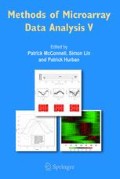Abstract
Identification of periodically expressed genes (PEGs) has been widely studied, but understanding how PEGs are distributed along chromosomes is largely unexplored. In this study we investigated chromosomal clusters of PEGs in stages of intraerythrocytic developmental cycle (IDC) of Plasmodium falciparum using the cDNA microarray data provided by the organizers of the Critical Assessment of Microarray Data Analysis (CAMDA) 2004 competition. To this end, we implemented an analysis consisting of three stages: first, fitting sinusoidal curves to the 46 time points to identify periodically expressed oligonucleoitides, second, using a support vector machine (SVM) to assign the periodically expressed oligonucleoitides to the four known developmental stages of the IDC, and third, defining stage-specific physically adjacent clusters and evaluating through permutation whether there were more clusters than expected by chance. We identified 2949 periodically expressed oligonucleoitides (2204 genes) where periodicity explained at least 70% of the variation over time, and 718, 624, 141, and 167 genes were assigned to the ring/early trophozoite, trophozoite/early schizont, schizont, and early ring stages, respectively, with at least 80% probability for stage prediction. Finally, we identified 312 clusters of two or more adjacent genes assigned to the same stage. Using a permutation-based method, we found that we observed more clusters of size five than expected by chance (p = 0.04). There was also a suggestion (p ∼ 0.10) of more clusters than expected for other cluster sizes. Our findings suggest that the expression of periodically expressed genes may be coordinated locally on chromosomes where there are clusters of genes within same stage, suggesting cis-regulation.
Access this chapter
Tax calculation will be finalised at checkout
Purchases are for personal use only
Preview
Unable to display preview. Download preview PDF.
References
Anderson, M.J. and Legender, P., An empirical comparison of permutation methods for tests of partial regression coefficients in a linear model, Journal of Statistical Computation and Simulation, 62 (1999), 271–303.
Benjamini, Y. and Hochberg, Y., Controlling the false discovery rate: A practical and powerful approach to multiple testing, Journal of the Royal Statistical Society B, 85 (1995), 289–300.
Booth, J.G., Casella, G., Cooke, J.E.K., and Davis, J.M., Clustering periodically expressed genes using mciroarray data: A statistical analysis of the yeast cell cycle data, Statistics Department Technical Report, University of Florida, 2003.
Bozdech, et al., The transcriptome of the intraerythrocytic developmental cycle of Plasmodium falciparum, PloS Biology, 1 (2003), 1–16.
Caron, H. et al., The human transcriptome map: Clustering of highly expressed genes in chromosomal domains, Science, 291 (2001), 1289–1292.
Chaudhuri, P. and Marro, J.S., SiZer for exploration of structures in curves, Journal of the American Statistical Association, 94 (1999), 807–823.
Cohen, B.A., Mitra, R.D., Hughes, J.D., and Church, G.M., A computational analysis of whole-genome expression data reveals chromosomal domains of gene expression, Nature Genetics, 26 (2000), 183–186.
Dudoit, S., Shaffer, J.P., and Boldrick, J.C., Multiple hypothesis testing in microarray experiments, Statistical Science, 18 (2003), 71–103.
Florens, L. et al., A proteomic view of the Plasmodium falciparum life cycle, Nature, 419 (2002), 520–526.
Friedman, F., Another approach to polychotomous classification, Statistics Department Technical Report, Stanford University, 1996.
Hastie, T. and Tibshirani, R., Classification by pairwise coupling, The Annals of Statistics, 26 (1998), 451–471.
Lu, X., Zhang, W., Qin, Z.S., Kwast, K.E., and Liu, J.S., Statistical resynchronization and Bayesian detection of periodically expressed genes, Nucleic Acids Research, 32 (2004), 447–455.
Miller, S.K. et al., A subset of Plasmodium falciparum SERA genes are expressed and appear to play an important role in the erythrocytic cycle, Journal of Biology Chemistry, 277 (2002), 47524–47532.
Platt, J., Probabilistic outputs for support vector machines and comparison to regularized likelihood methods, in: A. Smola, P. Bartlett, B. Schoelkopf, and D. Schuurmans (Eds.), Advances in Large Margin Classifiers, MIT Press, Cambridge, MA, 2000.
Roy, P.J. et al., Chromosomal clustering of muscle-expressed genes in Caenorhabditis elegans, Nature, 418 (2002), 975–979.
Spellman, P.T. et al., Comprehensive identification of cell-cycle-regulated genes of the Yeast saccharomyces cerevisiae by microarray hybridization, Molecular Biology of the Cell, 9 (1998), 3723–3297.
Taylor, J., Tibshirani, R., and Efron, B., The “Miss rate” for the analysis of gene expression data, Biostatistics, 6 (2005), 111–117.
Troyanskaya, O. et al., Missing value estimation methods for DNA microarrays, Bioinformatics, 17 (2001), 520–525.
Whitfield, M.L. et al., Identification of genes periodically expressed in the human cell cycle and their expression in tumors, Molecular Biology of the Cell, 13 (2002), 1977–2000.
Vapnik, V., Statistical Learning Theory, Wiley, 1998.
Author information
Authors and Affiliations
Editor information
Editors and Affiliations
Rights and permissions
Copyright information
© 2007 Springer Science+Business Media, LLC
About this chapter
Cite this chapter
Hu, P., Greenwood, C.M.T., M’lan, C.E., Beyene, J. (2007). Chromosomal Clustering of Periodically Expressed Genes in Plasmodium falciparum . In: McConnell, P., Lin, S.M., Hurban, P. (eds) Methods of Microarray Data Analysis V. Springer, Boston, MA. https://doi.org/10.1007/978-0-387-34569-7_8
Download citation
DOI: https://doi.org/10.1007/978-0-387-34569-7_8
Publisher Name: Springer, Boston, MA
Print ISBN: 978-0-387-34568-0
Online ISBN: 978-0-387-34569-7
eBook Packages: Biomedical and Life SciencesBiomedical and Life Sciences (R0)

